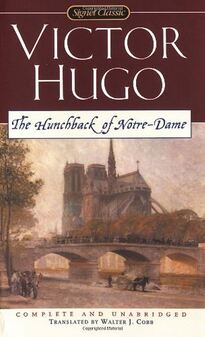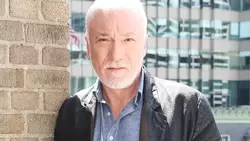Overview

Timpview Theatre is excited to bring this tragic, yet powerful story to life.
This adaptation of the classic Victor Hugo(Les Miserables) novel tells the story of Quasimodo, a deformed man feared by the people of Paris, who wastes away within the Notre Dame cathedral under the righteous, but troubled Claude Frollo. His life changes upon falling in love with Esmeralda, a beautiful Romani woman. Those in this story shall notice the struggle, sacrifice, and consequence of reaching for what one desires. Join us this November to see this humane display of conflict brought to our stage by talented teachers and students.
This adaptation of the classic Victor Hugo(Les Miserables) novel tells the story of Quasimodo, a deformed man feared by the people of Paris, who wastes away within the Notre Dame cathedral under the righteous, but troubled Claude Frollo. His life changes upon falling in love with Esmeralda, a beautiful Romani woman. Those in this story shall notice the struggle, sacrifice, and consequence of reaching for what one desires. Join us this November to see this humane display of conflict brought to our stage by talented teachers and students.
Portrayal Of Disability
To better understand how Quasimodo fits into the larger landscape of disability representation in
theater and other media, it’s important to figure out where we are now. The disabled community is the
largest minority group in the country, but it is the most underrepresented in the media, which has led
to an ongoing conversation in the disabled community about how people with disabilities are portrayed onstage and in other media. The adjacent charts and statistics from the 2017 study, “Inequality in 900 Popular Films”offer a clearer picture of where we are now with representation. (Also noteworthy: None of these disabled roles depicted a member from the L.G.B.T.Q. community or an underrepresented racial/ethnic group.)
"There’s no way to fully embody Quasimodo’s humanity without his physical differences. The trick, as I see it from an acting perspective, is to “perform disability,” but not to the extent that it would hinder the storytelling. In my experience, audiences and the general public have a limited awareness and understanding of disability and the community’s historical, political, and cultural complexities. Disability is a diverse, complex series of populations within a larger diaspora that has no specific geographic center and represents no one particular ethnicity, gender, class, socioeconomic status, or creed. Put simply: It doesn’t discriminate."
theater and other media, it’s important to figure out where we are now. The disabled community is the
largest minority group in the country, but it is the most underrepresented in the media, which has led
to an ongoing conversation in the disabled community about how people with disabilities are portrayed onstage and in other media. The adjacent charts and statistics from the 2017 study, “Inequality in 900 Popular Films”offer a clearer picture of where we are now with representation. (Also noteworthy: None of these disabled roles depicted a member from the L.G.B.T.Q. community or an underrepresented racial/ethnic group.)
"There’s no way to fully embody Quasimodo’s humanity without his physical differences. The trick, as I see it from an acting perspective, is to “perform disability,” but not to the extent that it would hinder the storytelling. In my experience, audiences and the general public have a limited awareness and understanding of disability and the community’s historical, political, and cultural complexities. Disability is a diverse, complex series of populations within a larger diaspora that has no specific geographic center and represents no one particular ethnicity, gender, class, socioeconomic status, or creed. Put simply: It doesn’t discriminate."
Previous Actor's Perspective

I played the role of John in Cost of Living. I’d like to share some of my experiences playing him in the hope that it might assist you in approaching the role of Quasimodo. The fact that my character and I both have cerebral palsy is where our similarities end. John is a wheelchair user – I am not – and unlike me, he has a pronounced speech impediment as a result of his cerebral palsy. I initially approached the role from a purely experiential, physical level. In my own life, I have encountered several individuals with John’s particular physicality. Knowing the level of tension in my body, and how that might manifest in someone like John, I began by attempting to fully embody what I perceived as John’s reality. This meant “amping up” my own disability, resulting in an incredible amount of additional stress on my body. I will never forget the eerie hush that fell over the audience the first time I rolled myself onstage as John. A wheelchair is a powerful symbol; for many it is the key signifier of disability. I used this to my advantage, letting the wheelchair do a lot of the literal and metaphorical work for me. Instead of severely contorting my body, I adopted a posture suggestive of a physical alignment that is characteristic of someone with severe cerebral palsy. I chose to sit comfortably with my left foot slightly in front of my right on the foot rest of the wheelchair. I held my hands in loose fists with my four fingers wrapped around my thumbs. My left hand rested on my lap; my right, John’s stronger side, drove the chair. I also requested to work with avocal coach. Together, we worked to keep John’s particular idiosyncratic vocal patterns authentic without compromising my voice. We developed a pre-show vocal warm-up and a post-performance cool-down that I did every day during the run to sustain vocal health. My eventual approach to playing John was really no different than what I imagine any actor would do .Initially, I fell into the trap of playing the constraint or, in other words, showing how “disabled” John is. With the benefit of time, I began doing less physically, and as a result could devote more time to focusing on the scene and John’s essential humanity.

CIARA RENÉE (Esmeralda)

Patrick Page (Frollo)

